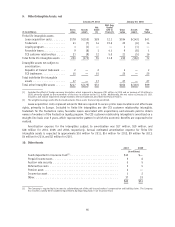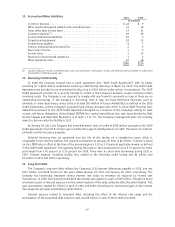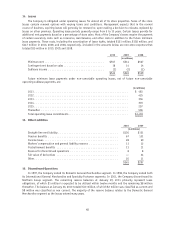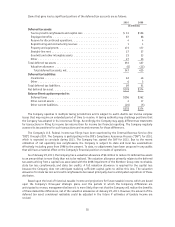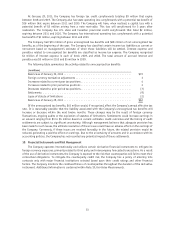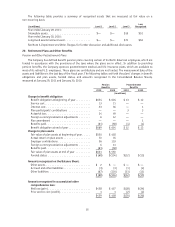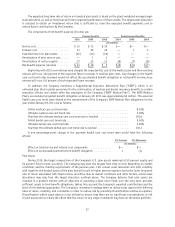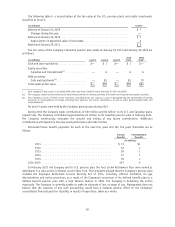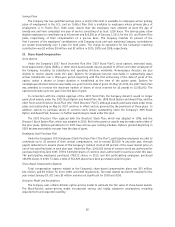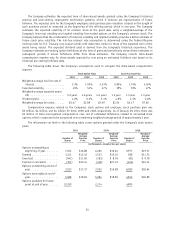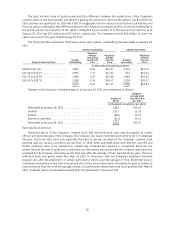Foot Locker 2010 Annual Report Download - page 71
Download and view the complete annual report
Please find page 71 of the 2010 Foot Locker annual report below. You can navigate through the pages in the report by either clicking on the pages listed below, or by using the keyword search tool below to find specific information within the annual report.Derivative Holdings Designated as Hedges
For a derivative to qualify as a hedge at inception and throughout the hedged period, the Company formally
documents the nature of the hedged items and the relationships between the hedging instruments and the
hedged items, as well as its risk-management objectives, strategies for undertaking the various hedge
transactions, and the methods of assessing hedge effectiveness and hedge ineffectiveness. In addition, for
hedges of forecasted transactions, the significant characteristics and expected terms of a forecasted transaction
must be specifically identified, and it must be probable that each forecasted transaction would occur. If it were
deemed probable that the forecasted transaction would not occur, the gain or loss would be recognized in
earnings immediately. No such gains or losses were recognized in earnings for any of the periods presented.
Derivative financial instruments qualifying for hedge accounting must maintain a specified level of effectiveness
between the hedging instrument and the item being hedged, both at inception and throughout the hedged
period, which management evaluates periodically.
The primary currencies to which the Company is exposed are the euro, the British pound, the Canadian dollar,
and the Australian dollar. For option and forward foreign exchange contracts designated as cash flow hedges of
the purchase of inventory, the effective portion of gains and losses is deferred as a component of accumulated
other comprehensive loss and is recognized as a component of cost of sales when the related inventory is sold.
The net changes in the fair value of foreign exchange derivative financial instruments designated as cash flow
hedges of the purchase of inventory was a reduction to accumulated other comprehensive loss of $1 million for
the year ended January 29, 2011 and an increase to accumulated other comprehensive loss of $3 million for the
year ended January 30, 2010. The amount reclassified to cost of sales related to such contracts was not
significant for any of the periods presented. The ineffective portion of gains and losses related to cash flow
hedges recorded to earnings was not significant for any of the periods presented. When using a forward contract
as a hedging instrument, the Company excludes the time value from the assessment of effectiveness. At each
year-end, the Company had not hedged forecasted transactions for more than the next twelve months, and the
Company expects all derivative-related amounts reported in accumulated other comprehensive loss to be
reclassified to earnings within twelve months.
Derivative Holdings Designated as Non-Hedges
The Company mitigates the effect of fluctuating foreign exchange rates on the reporting of foreign currency
denominated earnings by entering into currency option contracts. Changes in the fair value of these foreign
currency option contracts, which are designated as non-hedges, are recorded in earnings immediately within
other income. The realized gains, premiums paid and changes in the fair market value recorded in the
Consolidated Statements of Operations were not significant for the years ended January 29, 2011 and January 30,
2010, and resulted in $4 million of income for the year ended January 31, 2009.
The Company also enters into forward foreign exchange contracts to hedge foreign-currency denominated
merchandise purchases and intercompany transactions that are not designated as hedges. Net changes in the fair
value of foreign exchange derivative financial instruments designated as non-hedges were substantially offset by
the changes in value of the underlying transactions, which were recorded in selling, general and administrative
expenses. The amount recorded for all the periods presented was not significant.
The Company enters into diesel fuel forward and option contracts to mitigate a portion of the Company’s
freight expense due to the variability caused by fuel surcharges imposed by our third-party freight carriers.
Changes in the fair value of these contracts are recorded in earnings immediately. The effect was not significant
for any of the periods presented.
In 2008, the Company terminated its European net investment hedge by amending its existing cross
currency swap and entering simultaneously into a new cross currency swap, thereby fixing the amount owed to
the counterparty at $24 million. The agreement included an option, which was exercised by the counterparty that
required the Company to settle this transaction in August 2010.
52






